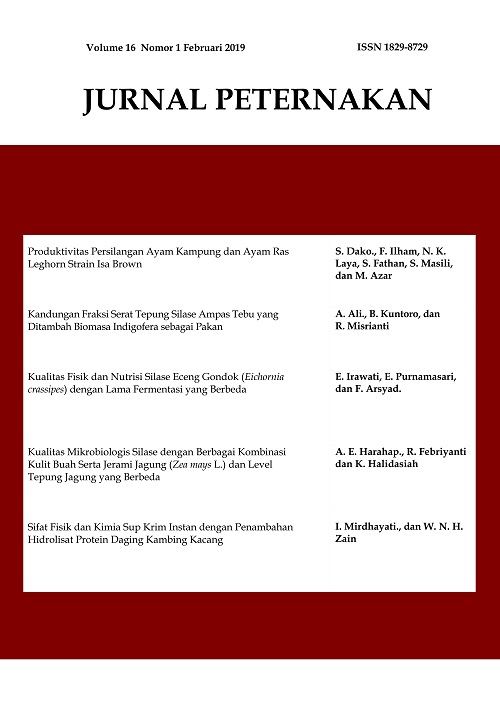KUALITAS MIKROBIOLOGIS SILASE DENGAN PENAMBAHAN BERBAGAI LEVEL KULIT BUAH DAN JERAMI JAGUNG (Zea mays L.) SERTA TEPUNG JAGUNG YANG BERBEDA
DOI:
https://doi.org/10.24014/jupet.v16i1.6653Abstract
Tujuan penelitian untuk mengetahui pH, populasi serta zona bening BAL terhadap E. coli yang diisolasi dari silase kulit buah dan jerami jagung dengan penambahan tepung jagung yang berbeda. Penelitian ini dilakukan dengan menggunakan Rancangan Acak Lengkap (RAL) pola faktorial dengan 3x3 perlakuan 3 ulangan untuk setiap perlakuan.: A1 100% Kulit Buah Jagung + 0% Jerami Jagung, A2 50% Kulit Buah Jagung + 50% Jerami Jagung A3 0% Kulit Buah Jagung + 100% Jerami Jagung. Faktor B: Penambahan Tepung Jagung B1 0% Tanpa Tepung Jagung B2 5% Tepung Jagung B3 10% Tepung Jagung. Hasil penelitian menunjukkan bahwa tidak terdapat interaksi antara faktor jenis bahan yang berbeda dengan penambahan tepung jagung terhadap pH, jumlah populasi bakteri asam laktat, dan zona bening BAL terhadap E. Coli. Kesimpulan perlakuan silase dengan penambahan jerami jagung 100% dapat dijadikan pakan ternak ruminansia.
References
Alakomi H.L., Skyttä E., Saarela M., Mattila S.T., Latva K.T., and Helander I.M. 2000. Lactic acid permeabilizes gram-negative bacteria by disrupting the outermembrane. Appl Environ Microbiol. 66 : 2001-2005.
Axelsson L. 1998. Lactic acid bacteria: Classification and physiology. Di dalam:Salminen S, Wright and A Von Wright, Editor. Lactic Acid Bacteria: Microbiology and functional aspects, 2nd Edition, Revised and Expanded. Marcel Dekker Inc. pp 1-72. New York.
Badan Pusat Statistika (BPS), 2015. Riau Dalam Angka. Badan Pusat Statistika Provinsi Riau. Pekanbaru.
Buckmaster, D. 1992. Bacterial Inoculants for Silage. http//www.ege.psu.edu/extension/ factsheets/i/I 111.pdf. Diakses pada tanggal 20 Desember 2016.
Cappucino, J.G., and N. Sherman. 2005. Microbiology a Laboratory Manual. 7 Th Edition. Pearson Education, Inc. San Francisco. USA
Chelule, P. K., Mokoena, M.P. dan Galeni, N. (2010). Advantages of Traditional Lactid Acid Bacteria Fermentation of Food in Africa. Current Research, Technology and Education Topics in Applied Microbiology and Mikrobial Biothecnology, 2: 1160-1167.
Cherney, DJR., Cherney JH, & Cox WJ. 2004. Fermentation Characteristics of Corn Forage Ensiled in Mini Silos. J. Dairy Sci. 87:4238-4246.
Chen, Y. & Z. G. Weinberg. 2008. Changes During Aerobic Exposure of Wheat Silages, Anim. Feed Sci and Tech. 154:76-82
Cintas, L.M., Rodriguez J.M., Fernandes M.F., Sletten K., Nes I.F., Hernandez P.E., and Holo H., 1995. Isolation and characterization of Pediocin L50, a new bacteriocin from Pediococus acidlactic with a broad inhibitory spectrum. Appl and Envir Microbiology, 61 (7) : 2643-2648.
Dwidjoseputro, D. 2005. Dasar -Dasar Mikrobiologi. Djambatan. Jakarta. hal.214
Gurning, F. N. 2013. Profil Jus Silase Jagung dan Kemampuannya dalam Menghambat Escherichia coli dan Salmonella sp. yang Diisolasi dari Feses Pedet Diare. Sekolah Pascasarjana. Laporan Penelitian. Institut Pertanian Bogor. Bogor.
Harahap, A. E. 2011. Kajian Daya Hambat Bakteri Asam Laktat Silase Ransum Komplit Berbasis Hasil Samping Jagung, Ubi Kayu dan Sawit. Jurnal Peternakan, 8 (2) : 44-48.
McDonald P, Henderson AR, Heron SJE. 1991. The Biochemistry of Silage. Second Edition. Aberystwyth (GB) : J Wiley.
Muck, R. E. 1990. Prediction of Lactic Acid Bacteria Numbers on Lucerne. Grass Forage Sci. 45:273-280.
Mugiawati, R. E. 2013. Kadar Air dan pH Silase Rumput Gajah pada Hari ke-21 dengan Penambahan Jenis Aditif dan Bakteri Asam Laktat. Jurnal Ternak Ilmiah, 1 (1): 201-207.
Nusio, L. G. 2005. Silage Production from Tropical Forages. In: Silage Production and Utilization. Park, R.S. and M.D. Stronge(Eds.). Wageningen Academic Publ., the Netherlands. Pp. 97-107.
Salminen, S., and Atte van W, 1998. Lactic Acid Bacteria Microbiology and Funcional aspect 2nd Ed. Marcel Dekker, Inc. New York. Basel.
Sibanda, S. R., M. Jingura, and J. H. Topps. 1997. The Effect of Level of Inclusion of the Legume Desmodium uncinatum and the use of Molasses or Ground Maize as Additives on the Chemical Composition of Grass-and Maize-Legume Silages. Anim feed Sci. Technol, 68:295-305.
Sudarmadji, S., Bambang H., dan Suhardi. 1997. Prosedur Analisa untuk Bahan Makanan dan Pertanian. Penerbit Angkasa. Bandung.
Umam, S., N. P. Indriani dan A. Budiman. 2014. Pengaruh Tingkat Penggunaan Tepung Jagung sebagai Aditif pada Silase Rumput Gajah (Pennisetum purpureum) terhadap Asam Laktat, NH3 dan pH, Jurnal. Fakultas Peternakan Universitas Padjajaran. Bandung.
Yang, C., M. J., S.C. Huang, T. Chang, Y.H. Cheng, and C.T. Chang. 2004. Fermentation Acids, Aerobic Fungal Growth, and intake of Napier Grass Ensiled with non Fiber Carbohidrates. Journal Dairy Sci, 87 : 630-636.
Downloads
Published
Issue
Section
License
The Authors submitting a manuscript do so on the understanding that if accepted for publication, copyright of the article shall be assigned to Jurnal Peternakan and published by Fakultas Pertanian dan Peternakan Universitas Islam Negeri Sultan Syarif Kasim Riau as publisher of the journal.
Authors who publish with this journal agree to the following terms:
Authors automatically transfer the copyright to the journal and grant the journal right of first publication with the work simultaneously licensed under a Creative Commons (CC BY) that allows others to share the work with an acknowledgement of the work's authorship and initial publication in this journal.
Authors are able to enter into separate permission for non-exclusive distribution of the journal's published version of the work (e.g., post it to an institutional repository or publish it in a book), with an acknowledgement of its initial publication in this journal.
Authors are permitted and encouraged to post their work online (e.g., in institutional repositories or on their website) prior to and during the submission process, as it can lead to productive exchanges, as well as earlier and greater citation of published work (See The Effect of Open Access).

